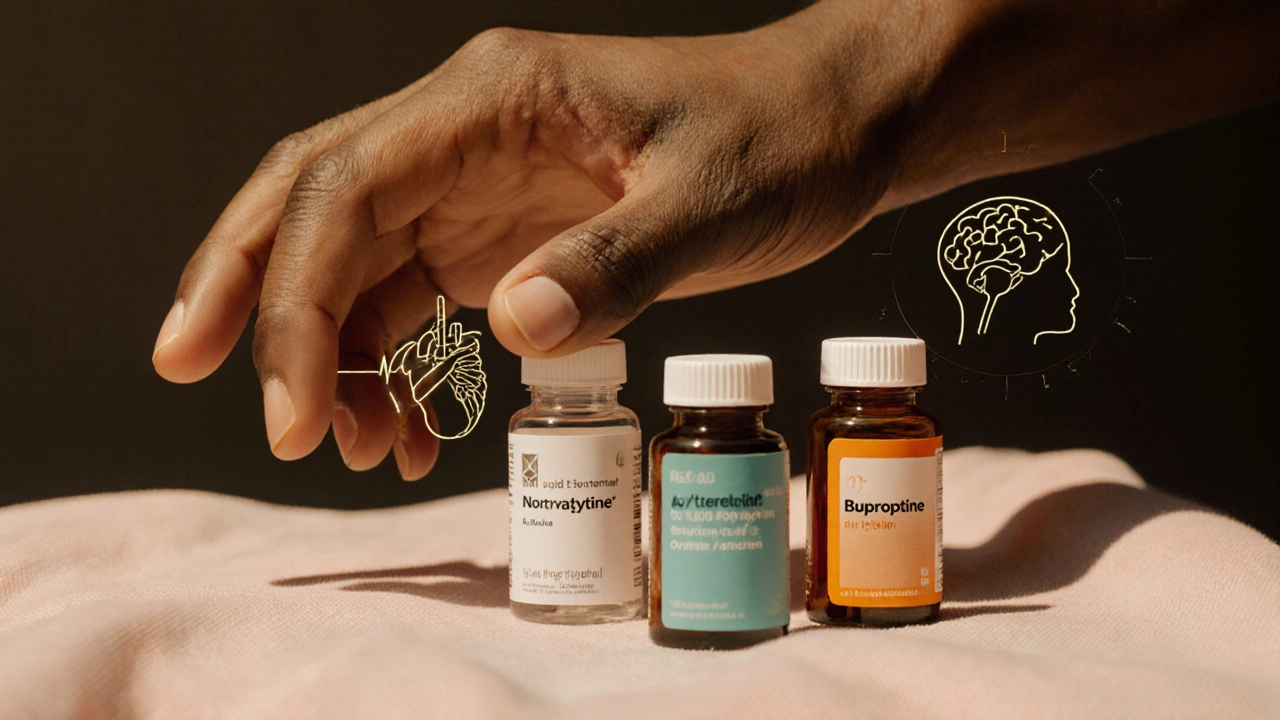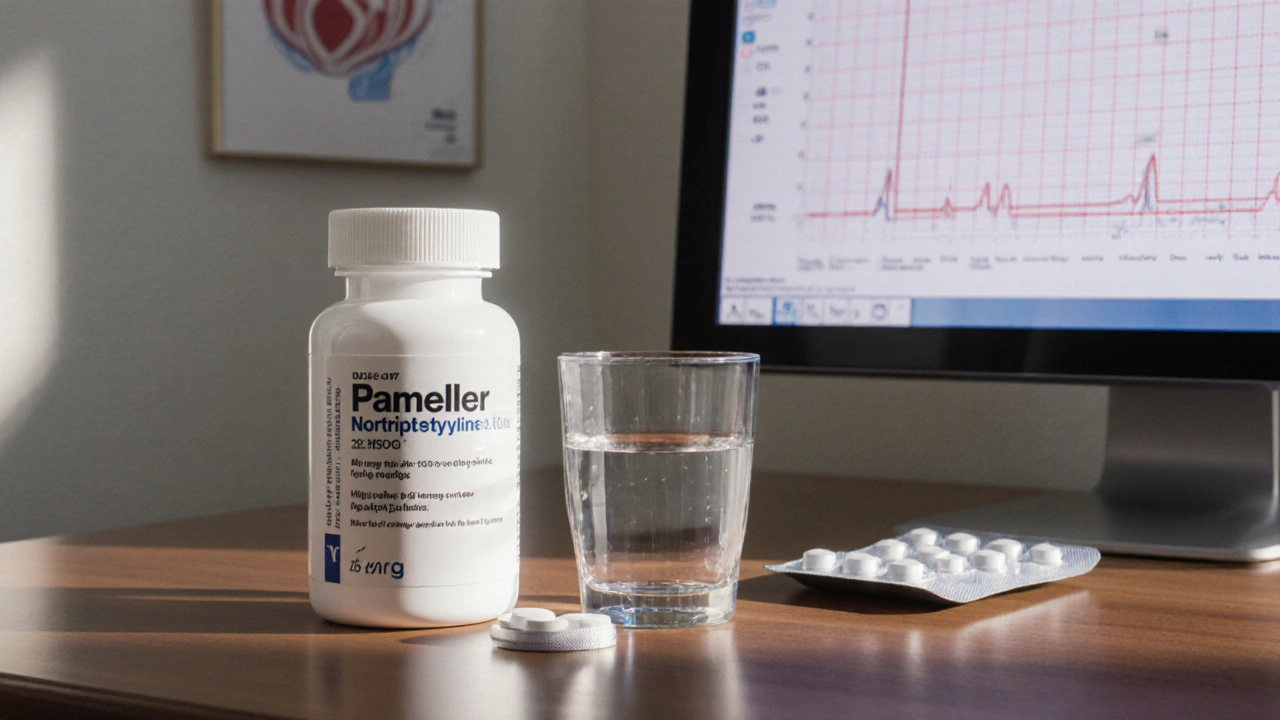Quick Takeaways
- Nortriptyline is a tricyclic antidepressant effective for depression and chronic pain, but it carries notable anticholinergic side effects.
- SSRIs (e.g., sertraline, escitalopram) generally have a milder side‑effect profile and are first‑line for many patients.
- SNRIs (venlafaxine, duloxetine) offer dual serotonin‑noradrenaline action, useful when pain relief is a priority.
- Atypical agents like bupropion avoid sexual dysfunction and weight gain, though they may raise seizure risk.
- Cost, drug interactions, and individual health factors (heart condition, glaucoma, pregnancy) should drive the final choice.
If you’ve been prescribed Nortriptyline (marketed as Pamelor) - a tricyclic antidepressant used for depression, anxiety, and neuropathic pain, you might wonder whether a different medication could work better for you. Below we break down how Nortriptyline stacks up against the most common alternatives, covering efficacy, side effects, dosing, cost, and safety considerations. By the end you’ll have a clear picture of which option aligns with your health goals and lifestyle.
How Nortriptyline Works and Who It Helps
Nortriptyline belongs to the tricyclic antidepressant (TCA) class. It blocks the re‑uptake of norepinephrine and serotonin, increasing their levels in the brain. This mechanism helps lift mood and can also dampen pain signals, making it a go‑to for conditions like major depressive disorder, generalized anxiety, and certain types of chronic pain (e.g., diabetic neuropathy).
Key attributes of Nortriptyline:
- Typical dose: Start at 25mg nightly, titrate up to 150mg based on response.
- On‑set of effect: 2‑4 weeks for mood, up to 6 weeks for pain relief.
- Side‑effect profile: Dry mouth, constipation, dizziness, weight gain, blurred vision, and potential cardiac rhythm changes.
Because TCAs can affect heart rhythm, doctors often run an ECG before prescribing Nortriptyline, especially for patients over 40 or those with known cardiac disease.
Main Alternatives Overview
When looking for a substitute, clinicians usually turn to three broader drug families:
- Selective serotonin re‑uptake inhibitors (SSRIs)
- Serotonin‑noradrenaline re‑uptake inhibitors (SNRIs)
- Atypical antidepressants
Each family has signature drugs that are widely available in the UK and covered by the NHS.
SSRIs
SSRIs boost serotonin alone and are generally better tolerated than TCAs.
Sertraline is an SSRI often used for depression, anxiety disorders, and obsessive‑compulsive disorder starts at 50mg daily, while Escitalopram is a highly selective SSRI prescribed for major depression and generalized anxiety disorder usually begins at 10mg daily. Both have mild side effects such as nausea and occasional insomnia, but they rarely cause the heart‑related risks seen with Nortriptyline.
SNRIs
SNRIs hit both serotonin and norepinephrine, offering a middle ground between SSRIs and TCAs.
Venlafaxine is an SNRI indicated for major depressive disorder, generalized anxiety disorder, and social anxiety starts at 37.5mg daily, titrating to 150mg or higher. Duloxetine is another SNRI commonly used for depression, neuropathic pain, and fibromyalgia begins at 30mg daily. Both can raise blood pressure at higher doses, so regular monitoring is advised.
Atypical Antidepressants
Atypical agents act on diverse neurotransmitter systems, providing alternatives for patients who can’t tolerate serotonin‑focused drugs.
Bupropion is a norepinephrine‑dopamine re‑uptake inhibitor used for depression and smoking cessation starts at 150mg once daily, often split into two doses. It’s notable for causing fewer sexual side effects and less weight gain, but it can lower the seizure threshold, especially above 300mg daily. Amitriptyline is another TCA, similar to Nortriptyline but with a stronger antihistamine effect, frequently prescribed for chronic migraine prevention and Desipramine is a TCA with a more selective norepinephrine effect, useful for certain anxiety disorders are still options when a TCA is specifically needed.
Detailed Comparison Table
| Drug | Class | Typical Starting Dose | Common Side Effects | Interaction Risk | Average Monthly Cost (NHS) |
|---|---|---|---|---|---|
| Nortriptyline | Tricyclic | 25mg nightly | Dry mouth, constipation, dizziness, weight gain | High (CYP2D6, cardiac QT) | £12 |
| Sertraline | SSRI | 50mg daily | Nausea, insomnia, sexual dysfunction | Medium (CYP2C19, serotonergic) | £8 |
| Escitalopram | SSRI | 10mg daily | Headache, fatigue, dry mouth | Medium (CYP2C19, serotonergic) | £9 |
| Venlafaxine | SNRI | 37.5mg daily | Increased BP, sweating, nausea | High (CYP2D6, serotonergic) | £10 |
| Duloxetine | SNRI | 30mg daily | Dry mouth, constipation, liver enzyme elevation | Medium (CYP1A2, serotonergic) | £11 |
| Bupropion | Atypical (NDRI) | 150mg once daily | Insomnia, dry mouth, increased seizure risk | Low (CYP2B6) | £13 |
| Amitriptyline | Tricyclic | 25mg nightly | Heavy sedation, weight gain, anticholinergic | High (CYP2D6, cardiac QT) | £12 |
| Desipramine | Tricyclic | 25mg daily | Dizziness, dry mouth, tachycardia | High (CYP2D6, cardiac QT) | £12 |
Choosing the Right Alternative for You
Not every drug suits every person. Below are common scenarios and the option that typically shines.
- First‑line for uncomplicated depression: Start with an SSRI like sertraline or escitalopram. They have the best balance of efficacy and tolerability.
- When chronic pain is a major driver: SNRIs (duloxetine) or the TCA amitriptyline often provide dual mood‑and‑pain relief.
- Concern about sexual side effects: Bupropion is a go‑to because it does not significantly affect libido.
- History of heart disease or arrhythmia: Avoid TCAs (nortriptyline, amitriptyline, desipramine); prefer SSRIs or SNRIs.
- Need for rapid mood lift (within 2 weeks): Bupropion and venlafaxine sometimes act faster, but close monitoring is essential.
Always discuss any plan with your GP or psychiatrist. They can run baseline labs (liver function, kidney function, ECG) and adjust doses safely.

Practical Tips & Common Pitfalls
Switching from Nortriptyline to another agent isn’t always a straight swap. Here are five things to watch out for:
- Cross‑tapering period: For TCAs to SSRIs, a 1‑week overlap at low dose reduces withdrawal symptoms.
- Blood pressure checks: SNRIs can raise systolic pressure; schedule a check after the first month.
- Drug‑food interactions: TCAs should be taken with food to lessen stomach upset, while bupropion is best on an empty stomach.
- Genetic metabolism: Some patients are poor CYP2D6 metabolizers, making TCAs accumulate dangerously. Pharmacogenetic testing can guide the choice.
- Pregnancy considerations: SSRIs like sertraline have the most safety data; many TCAs are avoided unless benefits outweigh risks.
Frequently Asked Questions
Can I stop Nortriptyline abruptly?
No. Stopping suddenly can cause withdrawal (headache, nausea, irritability). Taper the dose over 2‑4 weeks under medical supervision.
Is Sertraline more effective than Nortriptyline for depression?
Both are effective, but large meta‑analyses show SSRIs have similar remission rates with fewer cardiac side effects, so they’re usually preferred as first‑line.
What’s the biggest advantage of Duloxetine over Nortriptyline?
Duloxetine targets both serotonin and norepinephrine without the strong anticholinergic effects that cause dry mouth and constipation.
Can I take Bupropion if I have a history of seizures?
Only at low doses and with close monitoring. Most clinicians avoid it if you’ve had a seizure in the past year.
How long does it take for Venlafaxine to show benefit?
Usually 2‑3 weeks for mood improvement, but full effect can take up to 6 weeks, similar to other antidepressants.
Is there a generic version of Nortriptyline in the UK?
Yes, the NHS provides a generic Nortriptyline tablet, which keeps the price around £12 per month.
Switching antidepressants is a personal decision that blends clinical evidence with how your body reacts. Use this guide to talk confidently with your prescriber, weigh the pros and cons, and find a medication that fits your daily life.
